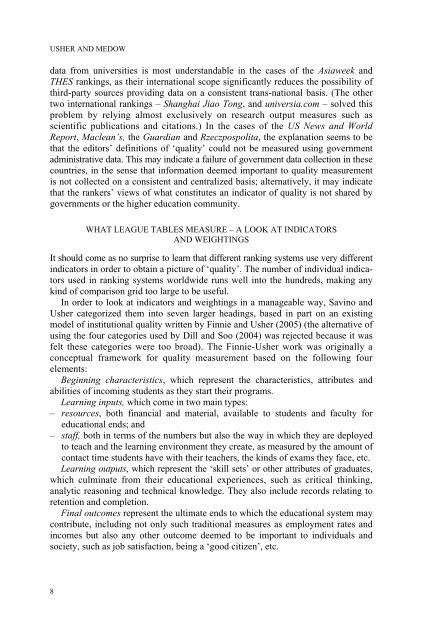University Rankings, Diversity, and the New ... - Sense Publishers
University Rankings, Diversity, and the New ... - Sense Publishers
University Rankings, Diversity, and the New ... - Sense Publishers
You also want an ePaper? Increase the reach of your titles
YUMPU automatically turns print PDFs into web optimized ePapers that Google loves.
USHER AND MEDOW<br />
data from universities is most underst<strong>and</strong>able in <strong>the</strong> cases of <strong>the</strong> Asiaweek <strong>and</strong><br />
THES rankings, as <strong>the</strong>ir international scope significantly reduces <strong>the</strong> possibility of<br />
third-party sources providing data on a consistent trans-national basis. (The o<strong>the</strong>r<br />
two international rankings – Shanghai Jiao Tong, <strong>and</strong> universia.com – solved this<br />
problem by relying almost exclusively on research output measures such as<br />
scientific publications <strong>and</strong> citations.) In <strong>the</strong> cases of <strong>the</strong> US <strong>New</strong>s <strong>and</strong> World<br />
Report, Maclean’s, <strong>the</strong> Guardian <strong>and</strong> Rzeczpospolita, <strong>the</strong> explanation seems to be<br />
that <strong>the</strong> editors’ definitions of ‘quality’ could not be measured using government<br />
administrative data. This may indicate a failure of government data collection in <strong>the</strong>se<br />
countries, in <strong>the</strong> sense that information deemed important to quality measurement<br />
is not collected on a consistent <strong>and</strong> centralized basis; alternatively, it may indicate<br />
that <strong>the</strong> rankers’ views of what constitutes an indicator of quality is not shared by<br />
governments or <strong>the</strong> higher education community.<br />
WHAT LEAGUE TABLES MEASURE – A LOOK AT INDICATORS<br />
AND WEIGHTINGS<br />
It should come as no surprise to learn that different ranking systems use very different<br />
indicators in order to obtain a picture of ‘quality’. The number of individual indicators<br />
used in ranking systems worldwide runs well into <strong>the</strong> hundreds, making any<br />
kind of comparison grid too large to be useful.<br />
In order to look at indicators <strong>and</strong> weightings in a manageable way, Savino <strong>and</strong><br />
Usher categorized <strong>the</strong>m into seven larger headings, based in part on an existing<br />
model of institutional quality written by Finnie <strong>and</strong> Usher (2005) (<strong>the</strong> alternative of<br />
using <strong>the</strong> four categories used by Dill <strong>and</strong> Soo (2004) was rejected because it was<br />
felt <strong>the</strong>se categories were too broad). The Finnie-Usher work was originally a<br />
conceptual framework for quality measurement based on <strong>the</strong> following four<br />
elements:<br />
Beginning characteristics, which represent <strong>the</strong> characteristics, attributes <strong>and</strong><br />
abilities of incoming students as <strong>the</strong>y start <strong>the</strong>ir programs.<br />
Learning inputs, which come in two main types:<br />
– resources, both financial <strong>and</strong> material, available to students <strong>and</strong> faculty for<br />
educational ends; <strong>and</strong><br />
– staff, both in terms of <strong>the</strong> numbers but also <strong>the</strong> way in which <strong>the</strong>y are deployed<br />
to teach <strong>and</strong> <strong>the</strong> learning environment <strong>the</strong>y create, as measured by <strong>the</strong> amount of<br />
contact time students have with <strong>the</strong>ir teachers, <strong>the</strong> kinds of exams <strong>the</strong>y face, etc.<br />
Learning outputs, which represent <strong>the</strong> ‘skill sets’ or o<strong>the</strong>r attributes of graduates,<br />
which culminate from <strong>the</strong>ir educational experiences, such as critical thinking,<br />
analytic reasoning <strong>and</strong> technical knowledge. They also include records relating to<br />
retention <strong>and</strong> completion.<br />
Final outcomes represent <strong>the</strong> ultimate ends to which <strong>the</strong> educational system may<br />
contribute, including not only such traditional measures as employment rates <strong>and</strong><br />
incomes but also any o<strong>the</strong>r outcome deemed to be important to individuals <strong>and</strong><br />
society, such as job satisfaction, being a ‘good citizen’, etc.<br />
8














